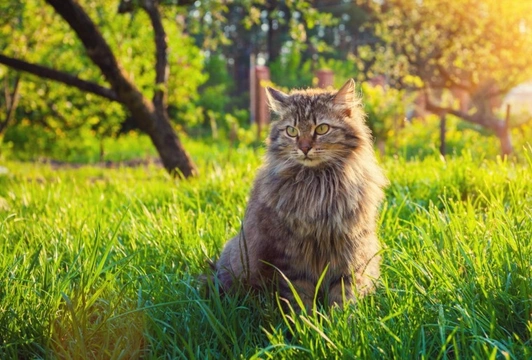
Worms and Internal Parasites in Cats
There are two major types of internal worms that can often affect cats - the roundworm and the tapeworm. However, it's possible (but less likely) that your cat could also attract some of the other less common varieties of internal parasite such as Toxoplasma gondii, lungworm or hookworm. You may not realise at first that your cat has got worms, as it's not always easy to see the symptoms unless they have reached an advanced stage, and it is therefore very important to worm your cat regularly as a preventative measure. Extreme symptoms include diarrhoea and vomiting, dehydration, weight loss (despite a good healthy appetite), skin irritation under the tail, and a general lack of condition.
Worms can be transmitted through eggs and larvae in the faeces, and your cat may pick them up in the garden, or even via a litter tray if you have another cat that has got worms. Worm eggs are sometimes eaten by mice and other rodents, as well as by birds, and if your cat is a bit of a 'hunter' he may pick them up when he eats his prey - the eggs will subsequently hatch, although this can sometimes take as long as two years to happen. The larvae may also transfer themselves into a cat's coat, and are then eaten when the cat grooms itself.
Roundworms are the most common form of the feline internal parasites, and there are two varieties, Toxocara cati and Toxascaris leonine, although the latter is not often found in Britain. Toxocara cati is a particular risk if you are a breeder, as a mother cat infected with roundworms can pass the larvae on to her kittens through her milk, because some of the dormant larvae may well travel into the mammary glands. Roundworms resemble very fine spaghetti, whereas tapeworms look like grains of rice and will often been seen in cat bedding and under the tail of the cat.
There are two varieties of segmented tapeworm that can affect a cat, Dipylidium caninum and Taenia taeniaeformis. Dipylidium is initially carried by cat fleas, and it then settles into the intestine of the cat. If a cat has fleas, it will generally have this variety of tapeworm as well, as the tapeworm larvae will be ingested whilst the cat is grooming itself. The larvae of the second type of tapeworm, Taenia, is not connected with fleas but is carried by rodents and birds in the same way as roundworm is, and again, it is outdoor cats that are more likely to be affected to this, and is mostly seen in older cats.
Most feline parasites are not commonly transferable between cats and humans, although it can and does happen occasionally. Humans can be susceptible to the effects of both roundworm and tapeworm larvae, which in rare cases can damage the human tissue, leading to eye damage or even blindness in the most extreme cases. This is more likely to affect a small child that accidentally ingests a cat flea as tapeworm larvae are often carried by cat fleas.
There is another small parasite that can sometimes live in the walls of the cat's intestine, called Toxoplasma gondii. This particular parasite can be contracted if a cat eats raw or undercooked infected meat, either the 'spoils' of a hunting expedition in the garden, or even accidentally provided by their human owners - raw meat should never be fed to cats because of this risk. The infected eggs are then expelled via the faeces, and it is for this reason that pregnant women should take special care when cleaning litter trays, or dealing with feline faeces, as they are particularly susceptible to toxoplasmosis. This can seriously affect an unborn baby, and it is advisable for them not to carry out this task if it can possibly be avoided. If it is absolutely necessary to do it, pregnant women should ensure that they wear disposable latex gloves, and then wash their hands with a strong anti-bacterial gel afterwards.
Less common forms of parasite include lungworm, which is not transferable to humans, but is a variety that lives in the air passages of a cat's lungs. The main sign of an infected cat is coughing, but this will be seen only once the cat has become extremely infected. Hookworm is rarely seen in Britain, but is a parasite that attaches itself to the inside of the cat's mouth, and can cause anaemia. You may also have heard of ringworm in cats, but this is in fact a serious fungal-based infection (which is very easily transmitted to humans), and despite the name, is not a worm at all.
There are many forms of treatment on the market for worms and parasites, but it is not a case of 'one size fits all' and you would be well advised to take your cat to your Vet if you think it may be suffering from this problem. Many over-the-counter remedies are quite weak and not very effective, and as the strong treatments target a specific parasite, your Vet will be able to see which one has affected your cat and prescribe an appropriate treatment to pinpoint the exact problem. Original worm treatment was always in tablet form, which is sometimes difficult to administer, but modern remedies also come in a more palatable form as well as liquid 'spot-on' applications, as well as liquids and granules that can be added to a tasty meal. Parasite and worm treatments can be administered after a problem has been diagnosed, although it is much better for the cat to give regular preventative treatment before it gets a grip and possibly causes the cat serious distress.



